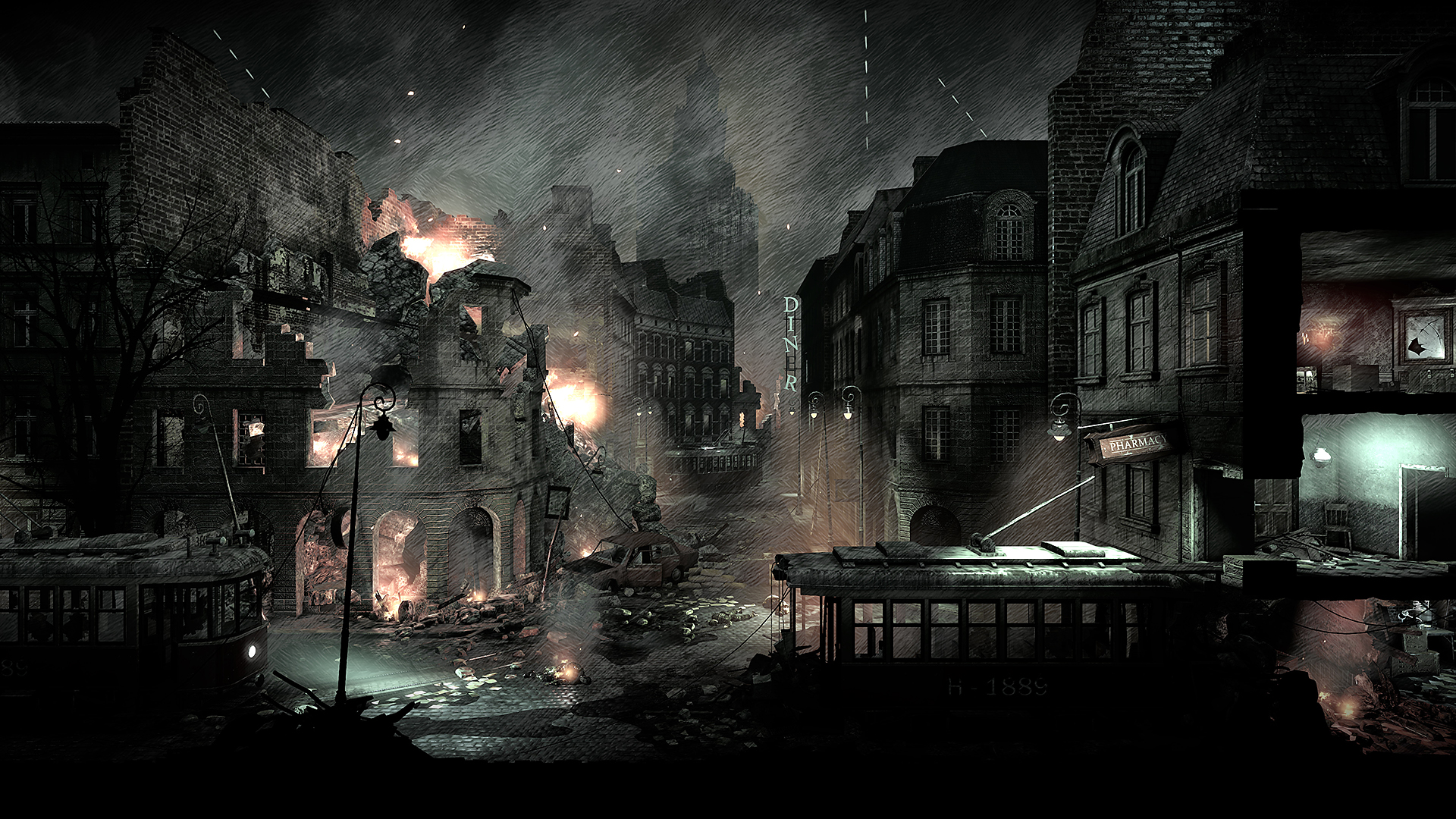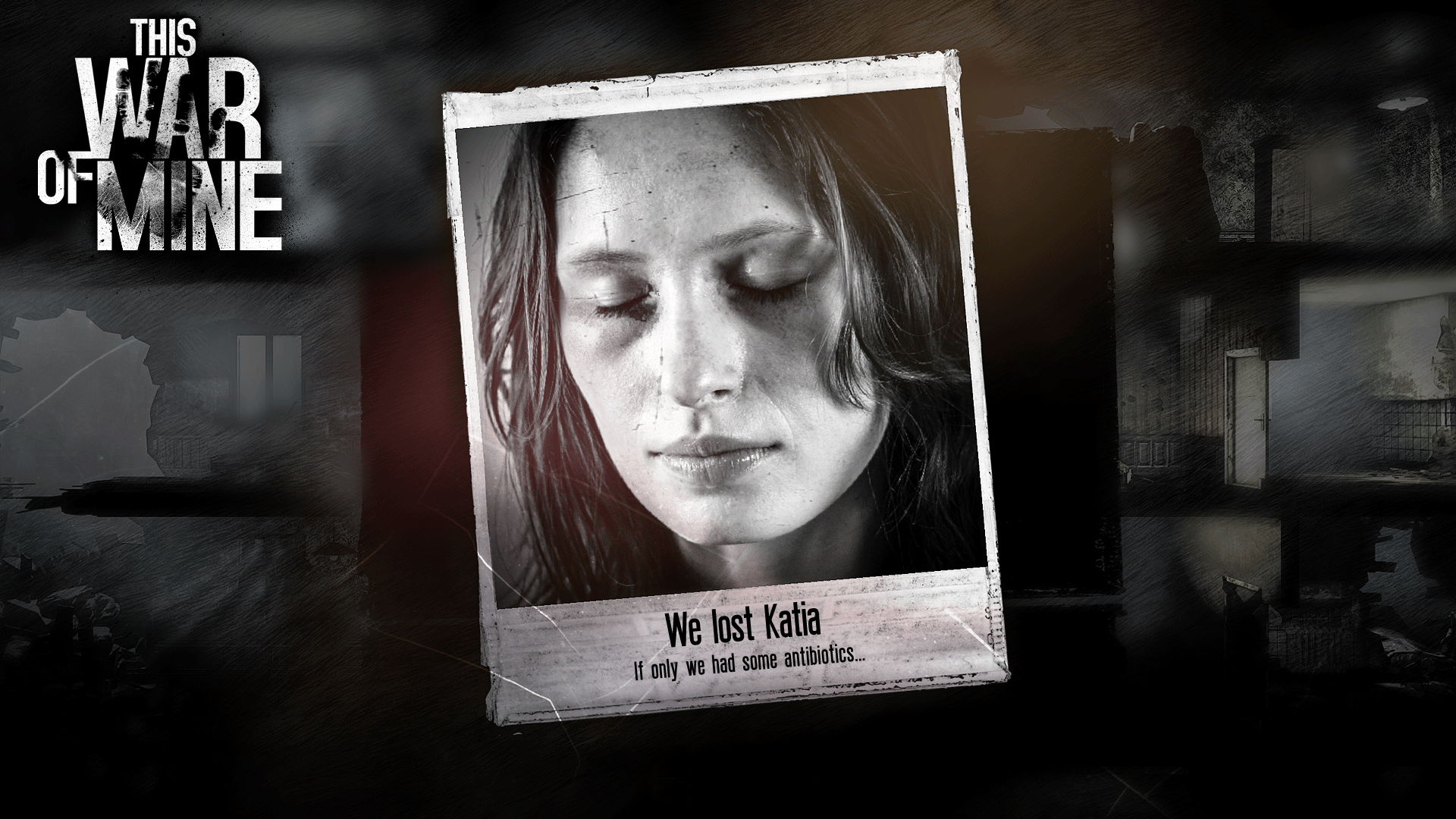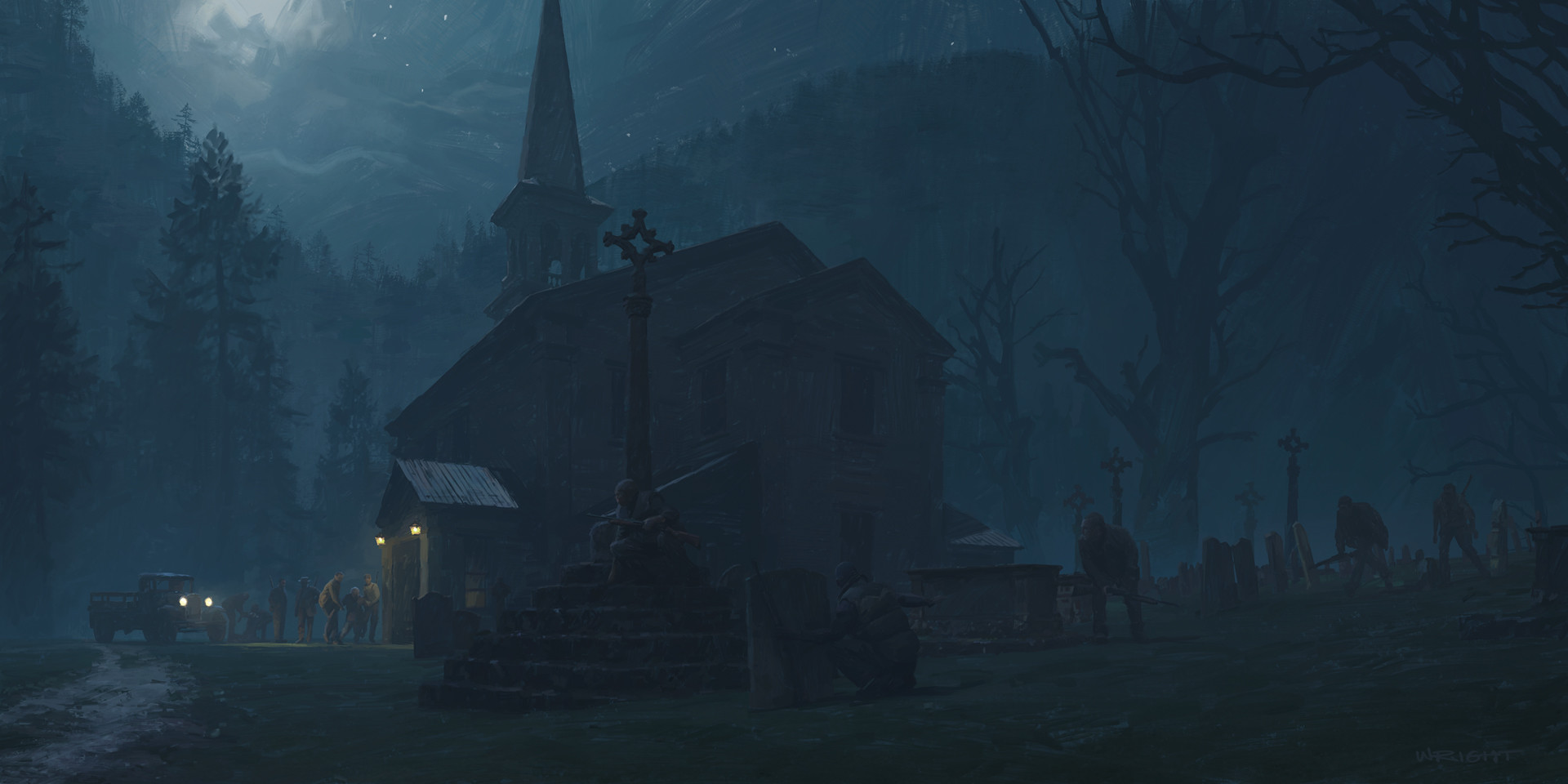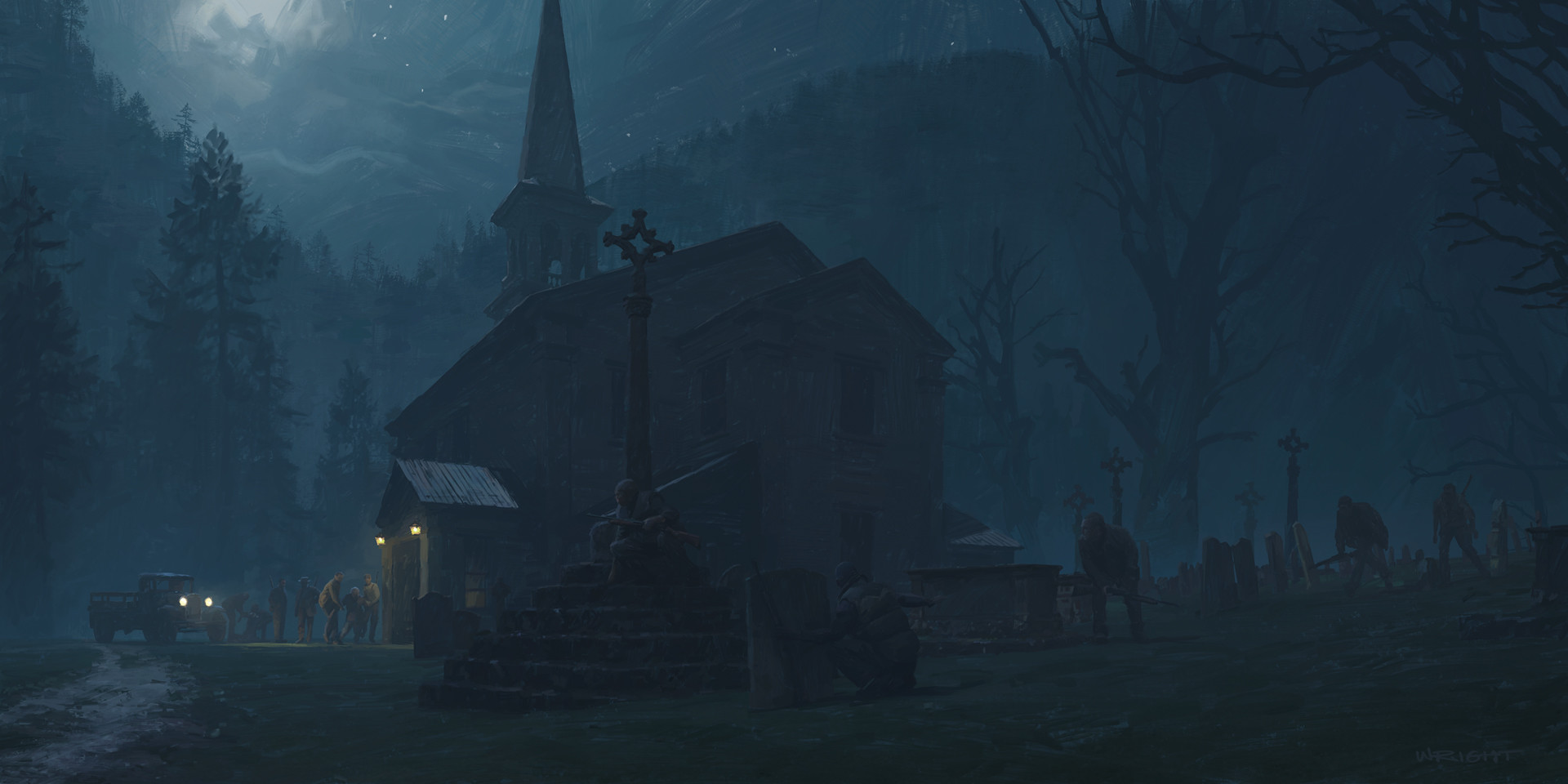During my relatively short voyage of the critical-making process and the serious game design approach, some new perspectives emerged from replaying games I believe to be not serious at all. This post shall examine three games, We Are Chicago, Frostpunk, and This War of Mine, and explore the player’s reception on how well the messages are delivered and received and try to find some typical caveats when designing serious games using the critical making process.
Case#1 This War of Mine
Visually stunning and narratively engaging, TWOM was an instant classic when it came out, the monochromatic aesthetics dominated by the aggressive application of black and white forms a stark contrast with the grey scale background while small bursts of colors are sprinkled in between.
 TWOM portrays a devastated city in the aftermath of a violent military conflict, rubbles, mutilated buildings, and mangled husks of metal consists of the majority of the game’s environment. The only life moving between the lifeless husks of civilization are the civilians struggling to survive. The game tasks you with maintaining the health, satiation, and sanity of three randomly selected civilians amidst this calamity. You need to employ desperate measures to survive, the decision between robbing other survivors or risking your life attacking an armed soldier will be the difference between life and death.
TWOM portrays a devastated city in the aftermath of a violent military conflict, rubbles, mutilated buildings, and mangled husks of metal consists of the majority of the game’s environment. The only life moving between the lifeless husks of civilization are the civilians struggling to survive. The game tasks you with maintaining the health, satiation, and sanity of three randomly selected civilians amidst this calamity. You need to employ desperate measures to survive, the decision between robbing other survivors or risking your life attacking an armed soldier will be the difference between life and death.
 Your survivors have their morality, and in their struggle, the game subtly challenges yours: Is it worth it to starve our cook so we can help the starving old man roaming the neighborhood even though he contributes little? Do you have the heart to close the door on desperate children begging for antibiotics so they can save their sick mother or risk having one of your own succumbing to infections? The game cleverly utilizes artificial scarcity to create tense and memorable moments but stops short of casting a definitive judgment. Ultimately you are the one doing the introspection on your own decisions. The game employs multiple characterization techniques from minor quips to heart-breaking monologues during meltdowns to create relatability and emotional engagements to make all the horrible decisions more heart-tugging.
Your survivors have their morality, and in their struggle, the game subtly challenges yours: Is it worth it to starve our cook so we can help the starving old man roaming the neighborhood even though he contributes little? Do you have the heart to close the door on desperate children begging for antibiotics so they can save their sick mother or risk having one of your own succumbing to infections? The game cleverly utilizes artificial scarcity to create tense and memorable moments but stops short of casting a definitive judgment. Ultimately you are the one doing the introspection on your own decisions. The game employs multiple characterization techniques from minor quips to heart-breaking monologues during meltdowns to create relatability and emotional engagements to make all the horrible decisions more heart-tugging.
 The general narrative is, surprisingly, quite shallow in my humble and honest opinion, the underlying narrative always criticizes violence and war while promoting cooperation and empathy. These central messages, while agreeable and easy to swallow, are nowhere near the morally grey decisions the players make depending on their actions. Thus, a more nuanced learning experience is generated by players that paid attention and played the game seriously. The recently reported wars also contributed to how my perspectives changed since the event seems not so distant anymore.
The general narrative is, surprisingly, quite shallow in my humble and honest opinion, the underlying narrative always criticizes violence and war while promoting cooperation and empathy. These central messages, while agreeable and easy to swallow, are nowhere near the morally grey decisions the players make depending on their actions. Thus, a more nuanced learning experience is generated by players that paid attention and played the game seriously. The recently reported wars also contributed to how my perspectives changed since the event seems not so distant anymore.
Case#2 Frostpunk
 After the success of TWOM, 11bit studio embarked on a grand journey to produce a narratively engaging resource-managed game on a large scale, and Frostpunk can be viewed as a direct escalation of This War of Mine. The entire world plunged into an endless ice age, resources are scarce, and no shelter can resist the wrath of winter. All except one, The Generator that greedily devours coals to produce heat and power that preserve life in the city. With more and more mouths to feed, hands to warm, and hearts to satisfy, you will face increasingly harsh challenges and the decision you might make in desperation or boredom. Will you send children into the mines for that last bit of coal reserve before the very air itself turns into the crystal and the sky falls upon us? Will you add sawdust to thin and tasteless soupy rations just to fill a few more bellies because the rampant criminal activities and doomsday cults sabotage your food supplies? Will you implement a 12-hour shift just to keep the ramshackle city keep going and risk the ire of the people or would you risk waking up to a city of frozen bodies and cold hearts? Frostpunk provides the player with plenty of challenges and countless morally questionable or downright evil decisions, and it is up to you to crave a new dawn for humanity in this dark age of ice by whatever means necessary or die trying.
After the success of TWOM, 11bit studio embarked on a grand journey to produce a narratively engaging resource-managed game on a large scale, and Frostpunk can be viewed as a direct escalation of This War of Mine. The entire world plunged into an endless ice age, resources are scarce, and no shelter can resist the wrath of winter. All except one, The Generator that greedily devours coals to produce heat and power that preserve life in the city. With more and more mouths to feed, hands to warm, and hearts to satisfy, you will face increasingly harsh challenges and the decision you might make in desperation or boredom. Will you send children into the mines for that last bit of coal reserve before the very air itself turns into the crystal and the sky falls upon us? Will you add sawdust to thin and tasteless soupy rations just to fill a few more bellies because the rampant criminal activities and doomsday cults sabotage your food supplies? Will you implement a 12-hour shift just to keep the ramshackle city keep going and risk the ire of the people or would you risk waking up to a city of frozen bodies and cold hearts? Frostpunk provides the player with plenty of challenges and countless morally questionable or downright evil decisions, and it is up to you to crave a new dawn for humanity in this dark age of ice by whatever means necessary or die trying.

The game seems to have all the packages for a successful serious game that provokes players to think about their morals and the motivations of society at large. The same framework of player decisions influencing their critical thinking is still there. But I consider the game inferior in the serious gaming and message delivery department than TWOM, simply because of one simple line.

This line thrown in the player’s face is the source of ire for countless people. Open a game distribution platform and look at Frostpunk’s reviews, I imagine it wouldn’t be hard to find one talking about the notorious ending message. You have made difficult decisions that no one is willing to make, you have endured all the hardships with the city and her people, you have come triumphant against the deadliest chill that halts entropy in its path, and the game asks you if this is worth it. This should be the spontaneous takeaway for players after they finished the game with a satisfactory ending and silently question their own decisions and critically examine their experiences. This very on-the-nose approach can be viewed as a challenge to the player’s progress and understanding of their entire journey, like smearing a piece of pottery with a red marker reminding you that you broke your last one. This significantly diminishes the player’s experiences and their serious takeaway message by invalidating their achievements and journey and delivering the critical thinking process heavy-handedly, causing it to be obnoxious rather than information and view-shattering.
Case#3 We are Chicago
Having played the game after reinstalling my system once, editing dll files twice, and countless crash-to-desktops. I still think the game has a nice core to build upon. The narrative of railed visual novel adventure style fits nicely with the limited assets and polishes, and the story itself is passable while containing a valuable core message and offering a perspective that is often neglected or shunned.
I do think the game suffers from the common suite of problems that plagues the more serious-play-orientated indie games. Limited resources and experiences can cause other aspects of a game to be underperforming within certain demographics. The gamers on Steam criticized the game almost solely on the technical issues and outdated graphics and visual assets while agreeing about the message and core promise the game is trying to deliver. At the core, We are Chicago seems to be a carefully considered package of messages vital to expand our perspectives on certain social issues and stigmas covered in mud and poor packaging, causing it to be hard to swallow when the medium of delivery is not pleasant to consume.
All-in-all, I believe the delivery and execution of serious-play-orientated games are vital to the reception of messages, thinking about how to package your lessons inside a digestible package is vital to the reception of your messages.

Rejection of Seriousness Play and Critical Thinking: Case Studies of Player Receptions

